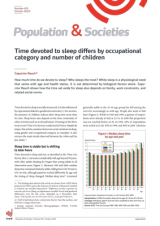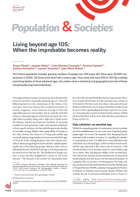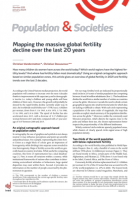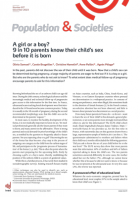
Time devoted to sleep differs by occupational category and number of children
Population and Societies
n° 615, October 2023
https://doi.org/10.3917/popsoc.615.0001
SAGE, Strasbourg University
Over 25 years, the time devoted to sleep remained stable, except among older adults, whose sleep time decreased. Its place in daily routines did not remain fixed, however. Bedtimes moved progressively later, partly due to the growing popularity of evening TV programmes that kept viewers up for longer.
Time devoted to sleep is socially structured. Sleep time is linked to gender and occupation. The impact of children on sleep time was stronger for women than for men. Being in employment reduced sleep time, but its effect was not the same for all occupational categories; it was manual workers whose sleep time varied the most between working and non-working days.
After retirement, the social differentiation in sleep time persisted, as the sleep patterns acquired during working life remained unchanged. Retirees formerly in higher-level or intermediate occupations slept less than farmers and manual workers.
time, sleep, rest, gender, age, occupational category, Time Use Survey, France
Table of contents
- Appendix A References
1.
How much time do we devote to sleep? Who sleeps the most? While sleep is a physiological need that varies with age and health status, it is not determined by biological factors alone. Capucine Rauch shows how the time set aside for sleep also depends on family, work constraints, and related social norms.
Time devoted to sleep is socially structured. It is also influenced by expectations linked to gendered social roles [1]: for women, the presence of children reduces their sleep time more than for men. Sleep hours also depend on the time constraints of other activities such as work and leisure. Drawing on the three most recent Time Use Surveys conducted in France (Emploi du temps), this article examines factors in social variations in sleep, using gender and occupational category as examples. It also retraces the main trends observed between the 1980s and the late 2000s.1
1.1. Sleep time is stable but is shifting to later hours
Time devoted to sleep and rest, as described in the Time Use Survey (Box 1), increases considerably with age beyond 50 years, with older adults sleeping for longer than young adults in all observation years (Figure 1). Between 1985 and 2009, median sleep time remained relatively stable, falling from 8 hr 50 min to 8 hr 40 min, although patterns evolved differently by age and the timing of sleep changed. Median sleep time2 remained generally stable in the 25–64 age group but fell among the over-65s, increasingly so with age. People also went to bed later (Figure 2). While in 1985 and 1998, a quarter of respondents were already in bed at 22.10, in 2009 this proportion was not reached before 22.30. In 1985, 60% of respondents were in bed at 23.00, 50% in 1998, and 40% in 2009. Likewise in 2009, it was not until midnight that three-quarters of the population were in bed, a share reached at 23.30 in 1998 and at 23.15 in 1985.
Staying up later, observed at all ages, is explained partly by the growing popularity of TV and the increased offering of late-night programmes. In 1998 and 2009, 71% of people watched TV between 20.00 and midnight, up from 58% in 1985. In parallel, prime-time programmes began later in 1998 than in 1985, moving from 20.30 to 21.00, and therefore finished later, at around 23.00. Between 1998 and 2009, the start of evening viewing returned to the earlier time of 20.35 for public service channels and 20.45 for private channels, and ended earlier. But over the same period, the average time spent watching TV increased from 1 hr 40 min to 2 hours, and viewers stayed up later. In 2009, almost three-quarters of evening viewers were still watching TV at 22.30 compared with just half in 1998.
As people started going to bed later, they also delayed their morning wake-up time. This explains the stability of sleep time observed between the surveys. The start of the working day also moved in the same direction. The shift in sleep hours between 1985 and 2009 thus corresponds to a reshaping of daily schedules, linked mainly to later TV viewing and its increasing popularity [2].
1.2. The oldest people sleep less at night and take fewer naps
The stability of sleep time observed across the population over a 25-year period does not apply to the oldest individuals. The median sleep time of retirees (and over-60s not in employment) fell by around 35 minutes, from 9 hr 55 min in 1985 to 9 hr 30 min in 1998 and 9 hr 20 min in 2009. This decrease between the mid-1980s and the late 2000s is observed at all retirement ages but is more pronounced among the oldest age groups. The median sleep time of the 65–69 age group decreased by 15 minutes (from 9 hr 15 min to 9 hours), that of the 70–74 age group by 45 minutes (from 9 hr 45 min to 9 hours); that of the 80–84 age group by more than 1.5 hours (from 11 hr 15 min to 9 hr 40 min), and that of the 85–90 age from by 1 hr 20 min (from 11 hr 20 min to 10 hours). This reduction is observed for men and women alike and concerns almost all retirees, whatever their age and former occupational category. Retirees formerly in higher-level occupations or business owners with more than 10 employees, who slept fewer hours, are an exception, with a sleep time that remained stable throughout the period. This decrease in sleep time may be due partly to improvements in health at a given age across cohorts for retirees from the lowest occupational categories, leading to a lesser need for sleep. The increase in time spent watching TV [3] may also have encroached on the time devoted to sleep.
Napping also became less frequent: while 54% of retirees napped for between 30 minutes and 3 hours on the day of the survey in 1985, only 45% did so in 2009. Napping was less frequent at all ages, for men and women alike, more especially among the over-70s.
1.3. A stronger impact of children on sleep time for women than for men
At ages 15–59, the median sleep time (all surveys included) was 8 hr 30 min. For women, it was 10 minutes longer than for men. However, family structure and employment status were different for men and women. Women more often have at least one child in their household than men (52% vs. 46%). They also more often completed the survey questionnaire on a non-working day than men (56% vs. 42%). This affects results, as people who did not work on the survey day slept for longer than those who worked (9 hr 20 min vs. 8 hours), and people with no children in the household slept for longer than those who had at least one. After controlling for the day (working, non-working) and sociodemographic characteristics, the gender gap in survey respondents’ sleep time disappears. This indicates that the gender differences initially observed were linked to differences in family structure and employment status.
At certain moments in the life course, women’s sleep, like their other activities, is influenced by expectations linked to gender roles. A birth increases gender inequalities in the division of domestic tasks [4], and women’s sleep is disrupted by the need to care for children and anticipate their needs and by the associated emotional labour (mental load). Venn et al. (2008 [5]) proposed the notion of the ‘fourth shift’ or ‘night shift’ to account for women’s first three ‘shifts’—employment, domestic work, and emotional labour—continuing into a fourth during the night.
The presence of children does not affect fathers’ and mothers’ sleep in the same way. When no children under 2 years old were in the household, men and women had an identical sleep time (all else equal). The presence of a child of this age reduced fathers’ sleep time by 12 minutes, but mothers’ sleep loss was double that of fathers, at 25 minutes. Similarly, sleep time decreased with the number of children for mothers, but not for fathers (Figure 3): childless men and fathers of three children slept for the same length of time (all else equal). Sleep time adjustment was gendered, with an unequal distribution of sleep loss between parents, to the disadvantage of mothers. This result is consistent with the ‘fourth shift’ or ‘night shift’ theory [5].
1.4. Sleep time persistently differs by occupational category
People in higher-level occupations had the shortest sleep time (around 8 hours), some 20–30 minutes less than the other occupational categories, although this duration varied between working and non-working days (Figure 4). On working days, it was self-employed people and farmers who slept most (8 hr 15 min) and those in higher-level occupations the least (7 hr 45 min). Conversely, on non-working days, it was manual workers who slept most (9 hr 30 min) and the self-employed and farmers who slept least (9 hours). It is among manual workers that the difference in sleep time between working and non-working days was largest (1 hr 40 min). These differences between occupational categories in sleep time on working and non-working days can be explained by a higher frequency of non-standard working hours (alternating schedules, night shifts) in some occupations than in others, longer working hours for higher-level occupations, or a greater need among manual workers to recuperate on rest days.
After retirement, despite the cessation of employment, the social differentiation in sleep time persisted, as the sleep patterns acquired during working life remained unchanged. Retirees formerly in higher-level or intermediate occupations slept less than farmers and manual workers. Long-established sleep patterns appear to act on sleep time throughout an individual’s life.
1.4.1. Box 1. Measuring sleep time in the French Time Use Surveys (Emploi du temps)
The Time Use Surveys conducted by INSEE since 1996 aim to document how individuals organize their time. The three most recent surveys (1985–1986, 1998–1999, and 2009–2010) were conducted on representative samples of people aged 15 and over living in ordinary (non-collective) households in metropolitan France.(a)
Survey respondents were asked to write a diary in their own words detailing all their activities in the day. The described activities were grouped into categories to compare the content of these diaries. The coding system varied across the surveys, however, with four sleep categories in 1985–1986, three in 2009–2010, and just one in 1998–1999. Moreover, consistent with European recommendations, rest periods (naps, for example) lasting less than 3 hours were coded in the 2010 survey as ‘doing nothing’, when previously they had been coded as ‘sleep’.
For consistency, we consider the categories corresponding to ‘doing nothing’ or ‘relaxing’ as periods of sleep (although they represent only a small fraction of daily activity). Consequently, the time labelled here as ‘sleep’ does not correspond to actual sleep, but rather to time devoted to sleep (or a similar activity). Moreover, while rarely recorded explicitly in respondents’ diaries, sleep time may also include time devoted to sexual activity.
The durations of sleep presented in this article appear to be longer than the average sleep times generally reported (around 7 hours). These disparities are linked mainly to measurement differences; the Time Use Survey applies a broad definition of sleep time. This article focuses on the time devoted to sleep and not on effective sleep time (when individuals are actually asleep). The stability of time devoted to sleep reported in the Time Use Surveys does not contradict the findings of studies that show a decrease in sleep time in France [6].
----------
(a) The 2009 survey is representative of metropolitan France (mainland France and Corsica) and the overseas departments, which are excluded from this study to ensure comparability between the three surveys.
Appendix A References
-
[1] Maume D. J., Hewitt B., Ruppanner L., 2018, Gender equality and restless sleep among partnered Europeans: Gender equality and restless sleep, Journal of Marriage and Family, 80(4), 1040–1058. https://doi.org/10.1111/jomf.12488
-
[2] Ricroch L., 2012, En 25 ans, le temps passé à dormir la nuit a diminué de 18 minutes, in INSEE (ed.), France, portrait social - Édition 2012, 107–118.
-
[3] Grobon S., Renaud T., 2018, Les activités des seniors : de moins en moins diversifiées passé 75 ans, in INSEE (ed.), France, portrait social - Édition 2018, 89–102.
-
[4] Régnier-Loilier A., 2009, L’arrivée d’un enfant modifie-t-elle la répartition des tâches domestiques au sein du couple ? Population & Sociétés, 461. https://doi.org/10.3917/popsoc.461.0001
-
[5] Venn S., Arber S., Meadows R., Hislop J., 2008, The fourth shift: Exploring the gendered nature of sleep disruption among couples with children, The British Journal of Sociology, 59(1), 79–97. https://doi.org/10.1111/j.1468-4446.2007.00183.x
-
[6] Léger D., Bourdillon F., 2019, Le déclin du temps de sommeil en France n’est pas une fatalité, Bulletin épidémiologique hebdomadaire, 8–9, 146–148.
The findings described in this article are drawn from a PhD thesis prepared at INED
and at the Sciences Po School of Research entitledLe sommeil, une variable d’ajustement ? Différences sociales et genrées au cours du cycle de vie (Sleep, an adjustment variable? Social and gendered differences over the life cycle),
defended on 2 December 2022
(http://hdl.handle.net/20.500.12204/AYUu_A1dLg0aT10RuaV3).
Half of individuals have a sleep time shorter than the median, and half have a longer sleep time.
Over 25 years, the time devoted to sleep remained stable, except among older adults, whose sleep time decreased. Its place in daily routines did not remain fixed, however. Bedtimes moved progressively later, partly due to the growing popularity of evening TV programmes that kept viewers up for longer.
Time devoted to sleep is socially structured. Sleep time is linked to gender and occupation. The impact of children on sleep time was stronger for women than for men. Being in employment reduced sleep time, but its effect was not the same for all occupational categories; it was manual workers whose sleep time varied the most between working and non-working days.
After retirement, the social differentiation in sleep time persisted, as the sleep patterns acquired during working life remained unchanged. Retirees formerly in higher-level or intermediate occupations slept less than farmers and manual workers.
Capucine Rauch (SAGE, Strasbourg University)
Cite the article
Capucine Rauch, Time devoted to sleep differs by occupational category and number of children, 2023, Population and Societies, no. 615
 This document may be reproduced free of charge on paper or online using our Creative Commons licence.
This document may be reproduced free of charge on paper or online using our Creative Commons licence.






